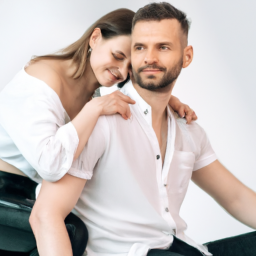In any relationship, communication plays a vital role in building trust, understanding, and a strong connection. However, it is not enough to simply exchange words; active listening is the key to truly comprehending your partner’s perspective. Active listening: understanding your partner’s perspective allows you to go beyond hearing their words and delve into their thoughts, emotions, and experiences. By engaging in empathic listening, you can create a safe and supportive space for your partner to express themselves, fostering a deeper level of understanding and connection in your relationship. In this blog post, we will explore the importance of active listening and provide practical tips on how to enhance this essential skill in your relationship.
The Importance of Active Listening in Building Strong Relationships
Building strong and healthy relationships is essential for our overall well-being and happiness. One of the key ingredients in creating these meaningful connections is active listening. Active listening is a powerful communication skill that allows us to truly understand our partner’s perspective, fostering empathy, trust, and mutual understanding. In this article, we will explore the significance of active listening in building strong relationships and provide you with a step-by-step guide to enhance your active listening skills.
The Power of Active Listening
Active listening goes beyond simply hearing what the other person is saying. It involves fully engaging with your partner, both verbally and non-verbally, to comprehend their thoughts, feelings, and needs. By actively listening, we demonstrate respect, empathy, and genuine interest in our partner’s experiences, which strengthens the emotional bond between us.
Active listening is not only about understanding the words spoken but also about grasping the underlying emotions and intentions behind them. It enables us to decode non-verbal cues, such as facial expressions, body language, and tone of voice, which often convey more than words alone. By paying attention to these cues, we can gain a deeper understanding of our partner’s perspective and respond in a more compassionate and supportive manner.
Furthermore, active listening promotes effective problem-solving and conflict resolution. When we actively listen, we create a safe space for our partner to express their concerns and frustrations. By validating their feelings and acknowledging their perspective, we can collaboratively find solutions and work towards a resolution that satisfies both parties. This fosters a sense of teamwork and strengthens the foundation of the relationship.
Step-by-Step Guide to Active Listening
1. Create a conducive environment: Find a quiet and comfortable space where you can both focus on the conversation without distractions. Make sure to eliminate any potential interruptions, such as turning off your electronic devices or closing the door. Creating a peaceful atmosphere sets the stage for effective active listening.
2. Give your undivided attention: Show your partner that you value their thoughts and opinions by giving them your full attention. Maintain eye contact, face them directly, and avoid multitasking or interrupting. By being fully present in the moment, you convey your genuine interest and willingness to listen.
3. Practice non-verbal cues: Non-verbal cues play a crucial role in active listening. Nodding your head, smiling, and using appropriate facial expressions show that you are engaged and understanding. Open body language, such as uncrossed arms and leaning slightly towards your partner, also conveys receptiveness. These non-verbal cues encourage your partner to continue sharing and feel heard.
4. Reflect and paraphrase: After your partner has expressed their thoughts, take a moment to reflect on what they have said. Paraphrase their words to ensure you have understood correctly. This not only demonstrates your active listening but also allows your partner to clarify any misunderstandings. For example, you can say, “If I understand correctly, you feel frustrated because…” This shows that you are actively processing their perspective.
5. Validate their emotions: Emotions are an integral part of any conversation. Validate your partner’s emotions by acknowledging and empathizing with them. Use phrases like, “I can understand why you would feel that way” or “It must be challenging for you.” Validating their emotions helps create a safe and supportive environment, where they feel comfortable expressing themselves honestly.
6. Ask open-ended questions: Encourage your partner to elaborate on their thoughts and feelings by asking open-ended questions. These questions cannot be answered with a simple “yes” or “no” and invite your partner to share more details. For instance, you can ask, “What led you to feel this way?” or “Can you tell me more about your perspective on this issue?” Open-ended questions promote deeper conversations and allow for a more comprehensive understanding.
7. Summarize and provide feedback: As the conversation progresses, periodically summarize the key points to ensure that you are on the same page. This shows that you are actively engaged and helps prevent miscommunication. Additionally, provide constructive feedback when appropriate, focusing on the behavior or situation rather than attacking your partner personally. Constructive feedback promotes growth and understanding within the relationship.
8. Practice empathy and understanding: Empathy is the cornerstone of active listening. Put yourself in your partner’s shoes and try to understand their perspective without judgment. Recognize that their experiences and feelings are valid, even if they differ from your own. By practicing empathy, you foster a deeper connection and build trust within the relationship.
9. Follow up and support: After the conversation, follow up with your partner to show that you value their thoughts and concerns. Check in on how they are feeling and offer support if needed. This demonstrates your commitment to the relationship and reinforces the idea that active listening is an ongoing process.
In conclusion, active listening plays a vital role in building strong and meaningful relationships. By practicing active listening, we can create an environment of trust, empathy, and understanding, which strengthens the emotional bond with our partner. Remember, it takes time and effort to develop active listening skills, but the rewards are immeasurable. Start implementing these steps today and watch as your relationships flourish.

Techniques for Practicing Active Listening to Better Understand Your Partner
In any relationship, communication plays a vital role in fostering understanding and connection between partners. Active listening is a powerful technique that can enhance your ability to comprehend your partner’s perspective, build trust, and strengthen your relationship. By engaging in active listening, you demonstrate empathy, respect, and a genuine interest in understanding your partner’s thoughts and feelings. In this article, we will explore effective techniques for practicing active listening to better understand your partner.
1. Give Your Full Attention
When engaging in a conversation with your partner, it is crucial to give them your undivided attention. Eliminate distractions such as electronic devices, TV, or other external stimuli that may hinder your ability to focus on what your partner is saying. Maintain eye contact and use non-verbal cues, such as nodding or smiling, to show that you are present and attentive.
Furthermore, avoid interrupting or formulating responses in your mind while your partner is speaking. Instead, let them express themselves fully before you provide any input. By giving your full attention, you create a safe and supportive environment for your partner to share their thoughts and emotions.
Remember, active listening is not just about hearing the words; it’s about understanding the underlying message and emotions conveyed by your partner.
2. Practice Reflective Listening
Reflective listening is a technique that involves paraphrasing and summarizing your partner’s words to ensure that you have understood their message accurately. It demonstrates your commitment to understanding their perspective and allows them to clarify any misunderstandings.
When practicing reflective listening, try to rephrase your partner’s statements in your own words. For example, if your partner says, “I feel overwhelmed with work,” you can respond by saying, “It sounds like you’re experiencing a lot of stress due to your workload.” This technique helps validate your partner’s feelings and encourages them to expand on their thoughts.
Additionally, summarizing the key points of the conversation can provide a helpful recap and ensure that both partners are on the same page. It shows that you have been actively engaged and have understood the main takeaways from the discussion.
3. Show Empathy and Validate Their Feelings
Empathy is a crucial component of active listening. It involves putting yourself in your partner’s shoes and understanding their emotions from their perspective. Validating your partner’s feelings demonstrates that you respect and acknowledge their experiences, even if you may not fully agree with them.
During a conversation, try to imagine how your partner might be feeling and express your understanding. For example, if your partner expresses frustration about a challenging situation at work, you can say, “I can understand why that would be frustrating for you.” This response conveys empathy and shows that you are actively trying to grasp their emotions.
Avoid dismissing or minimizing your partner’s feelings, as this can lead to a breakdown in communication and create distance between you. Remember, active listening is about fostering understanding and connection.
In conclusion, active listening is a powerful tool that can significantly improve your ability to understand your partner’s perspective. By giving your full attention, practicing reflective listening, and showing empathy, you create an environment where your partner feels heard, valued, and understood. Remember, active listening is an ongoing practice that requires patience, effort, and a genuine desire to connect with your partner on a deeper level. Start implementing these techniques today, and watch as your relationship blossoms with improved communication and understanding.

Enhancing Communication and Empathy Through Active Listening in Relationships
Effective communication is the cornerstone of any healthy relationship. It allows partners to understand each other’s perspectives, needs, and desires. One powerful tool that can significantly enhance communication and empathy in relationships is active listening. Active listening is a skill that involves fully focusing on, understanding, and responding to your partner’s words and emotions. By practicing active listening, you can create a safe and supportive environment for open and honest communication. In this article, we will explore the steps to actively listen to your partner and understand their perspective.
The Importance of Active Listening
Active listening is more than just hearing what your partner is saying; it involves truly understanding their thoughts, feelings, and experiences. By actively listening, you demonstrate empathy, respect, and genuine interest in your partner’s world. This level of engagement fosters trust and deepens your emotional connection. Moreover, active listening allows you to identify and address any misunderstandings or conflicts that may arise, leading to more effective problem-solving and resolution.
Now, let’s dive into the steps that can help you become an active listener and enhance communication and empathy in your relationship.
Step 1: Create a Supportive Environment
The first step towards active listening is creating a supportive environment for open and honest communication. Find a quiet and comfortable space where both you and your partner can feel relaxed and free from distractions. Make sure you have enough time to engage in a meaningful conversation without rushing.
Next, set the intention to be fully present and attentive during the conversation. Put away any distractions, such as phones or laptops, and maintain eye contact with your partner. By creating a safe and supportive environment, you encourage your partner to express themselves openly and honestly.
Additionally, it’s essential to cultivate a non-judgmental mindset. Avoid interrupting or jumping to conclusions while your partner is speaking. Instead, focus on understanding their perspective without imposing your own biases or judgments. Remember, the goal is to listen and understand, not to debate or prove a point.
Step 2: Practice Active Listening Techniques
Once you have established a supportive environment, it’s time to put active listening techniques into practice. These techniques will help you engage with your partner’s words, emotions, and non-verbal cues effectively.
Firstly, maintain eye contact and use affirmative gestures to show that you are actively listening. Nodding your head, smiling, or using facial expressions that reflect your partner’s emotions can convey your understanding and encouragement.
Secondly, provide verbal cues to indicate your engagement. Use phrases like “I see,” “I understand,” or “Tell me more” to encourage your partner to continue sharing their thoughts and feelings. Reflecting back their words by paraphrasing or summarizing what they’ve said can also demonstrate your active listening and ensure accurate understanding.
Lastly, pay attention to your partner’s non-verbal cues. Notice their body language, tone of voice, and any signs of discomfort or distress. By being attuned to these cues, you can better understand their emotions and respond with empathy and support.
Step 3: Respond with Empathy and Validation
Active listening is not just about hearing your partner; it’s about responding in a way that shows empathy and validation. Once your partner has shared their perspective, it’s crucial to respond in a manner that acknowledges their emotions and validates their experiences.
Start by expressing empathy and understanding. Use phrases like “I can imagine that must have been difficult for you” or “I understand why you feel that way.” By acknowledging your partner’s emotions, you create a sense of validation and acceptance.
Avoid immediately offering solutions or advice unless your partner specifically asks for it. Instead, focus on reflecting their feelings and experiences. Repeat back what you’ve heard, using phrases like “It sounds like you’re feeling…” or “I hear you saying…” This shows that you are actively engaged and seeking to understand their perspective.
Remember, active listening is an ongoing practice that requires patience, empathy, and a genuine desire to connect with your partner. By following these steps and consistently applying active listening techniques, you can enhance communication and empathy in your relationship, fostering a deeper and more fulfilling connection.
I’ll leave you with these final thoughts
In any relationship, communication is key. But it’s not just about speaking your mind; it’s also about actively listening to your partner. Active listening is a skill that allows you to truly understand and empathize with your partner’s perspective. It involves giving your undivided attention, showing genuine interest, and responding in a way that validates their feelings and experiences.
When you practice active listening, you create a safe space for your partner to express themselves openly and honestly. You set aside your own thoughts and judgments, focusing solely on what they are saying. This means avoiding distractions, such as scrolling through your phone or thinking about what you want to say next. Instead, you give your partner your full attention, maintaining eye contact and using non-verbal cues to show that you are fully present in the conversation.
By actively listening, you demonstrate empathy and understanding towards your partner. You try to see things from their perspective, even if you don’t necessarily agree. This helps build trust and strengthens the emotional connection between you both. Additionally, active listening allows you to pick up on subtle cues and emotions that may not be explicitly expressed. By acknowledging and validating their feelings, you create a supportive environment where your partner feels heard and valued.
In conclusion, active listening is a powerful tool for understanding your partner’s perspective. It requires genuine interest, undivided attention, and empathetic responses. By practicing active listening, you can foster better communication, strengthen your relationship, and create a deep sense of understanding and connection with your partner.
FAQ Roundup:
Q1: Why is active listening important in understanding my partner’s perspective?
A1: Active listening plays a crucial role in fostering a deep understanding of your partner’s perspective. By actively listening, you show genuine empathy and respect, creating an environment where your partner feels heard and valued. It enables you to grasp their thoughts, emotions, and experiences, leading to improved communication, stronger emotional connection, and a more harmonious relationship.
Q2: How can I practice active listening effectively?
A2: Practicing active listening involves several key elements. First, give your partner your undivided attention, eliminating distractions and focusing solely on them. Maintain eye contact, use affirmative body language, and show genuine interest in what they have to say. Secondly, refrain from interrupting or imposing your own opinions. Instead, encourage them to share more by asking open-ended questions and offering supportive responses. Lastly, reflect on their words and emotions, summarizing what you’ve understood to ensure accuracy and demonstrate your commitment to understanding their perspective.
Q3: What are some common barriers to active listening?
A3: Several barriers can hinder active listening. One common barrier is preoccupation with our own thoughts and concerns, which can prevent us from fully focusing on our partner. Another barrier is selective listening, where we only pay attention to certain aspects that align with our existing beliefs or biases. Additionally, distractions, such as electronic devices or external noise, can disrupt the listening process. It’s important to be aware of these barriers and actively work to overcome them to engage in effective active listening.
Q4: How does active listening contribute to resolving conflicts in a relationship?
A4: Active listening is a powerful tool for resolving conflicts in a relationship. By genuinely listening to your partner’s perspective, you gain a deeper understanding of their feelings, needs, and concerns. This understanding helps create a safe space for open and honest communication, enabling both partners to express themselves without judgment or defensiveness. As a result, conflicts can be addressed with empathy and respect, leading to collaborative problem-solving and a stronger bond between partners.
Q5: Can active listening help improve overall relationship satisfaction?
A5: Absolutely! Active listening is a key component of building and maintaining a healthy and satisfying relationship. When you actively listen to your partner, you validate their experiences and emotions, fostering a sense of trust and emotional intimacy. This, in turn, enhances overall relationship satisfaction. By investing time and effort into understanding your partner’s perspective through active listening, you create a solid foundation for effective communication, empathy, and mutual support, ultimately leading to a happier and more fulfilling relationship.



